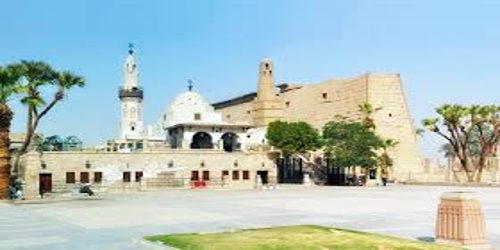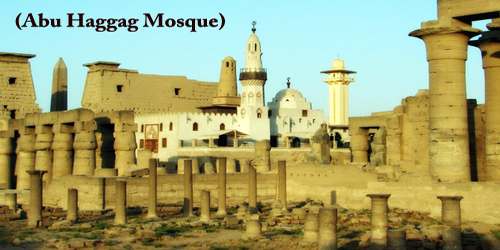The Mosque of Abu Haggag (Arabic: مسجد أبو الحجاج بالأقصر) is located on Luxor’s East Bank, in the Egyptian city of Luxor. In fact, it stands on top of the ruins of Luxor Temple, an ancient Egyptian worship center dating back to the 14th century BC reign of Pharaoh Amenhotep III. The architecture of this mosque resembles the architecture of the small Fatimid mosques on the bank of the Nile, such as the Esna Mosque at Aswan and Al-Mashhad el-Bahari. The mosque was not the first place of worship to be built on Luxor Temple ruins which had been a place of worship itself. Several churches were built around the temple before the mosque arrived, including one which stood at the exact same spot as the mosque does today. Sheikh Yusuf Abu el Haggag (c. 1150 – c. 1245), also al Haggag or Al-Hajjaj was a prophet and holy man whom Egyptians in the town of Luxor celebrate every year, on his mawlid (birthday) known as Mawlid Abu al-Hajjaj al-Uqṣūrī. The mosque was built on a little square area and contains a small dome. The doorway to the mosque is on the side. It’s well-known that some changes were made to the mosque within the Ayyubid era. The mosque was inbuilt the northeast area of Luxor Temple. It probably dates back to the center of the Fatimid era. The mosque itself sits upon the ancient columns. One of the most interesting aspects about this site is the fact that people of one or another faith have been worshipping here for over 35 years.

According to local legend, the Abu Haggag Mosque had already been inbuilt the primary court of the traditional Luxor Temple, and when a high-ranking official wanted it removed, Youssef protested. The doorway of the mosque has three arches, with heights of about 12 meters or 39 feet, covered with marble and faience. Probably this was one amongst the changes that was made within the Ayyubid age as manifested by the style. There is a niche inside the mosque of plain design, free of ornaments. There is also a small grave where they buried Yousef Ibn Abdel-Raheem, known as Abu Al-Haggag. On the highest of the mosque, there’s also a row of balconies that were built with baked bricks because it was restored in AD 1914 by Khedive Abbas Helmy the Second. Residents of Luxor city, on el Haggag’s Mawlid, dress up in colorful outfits and attend the mawlid festival for 3 days. The festival’s events also include horse races, Sufi music concerts, and three-day boat trips marking the occasion. El Haggag has descendants who are still living in Luxor, while some have left for places elsewhere. Many residents would save money year-round just to enjoy the celebrations and join a street procession.
















